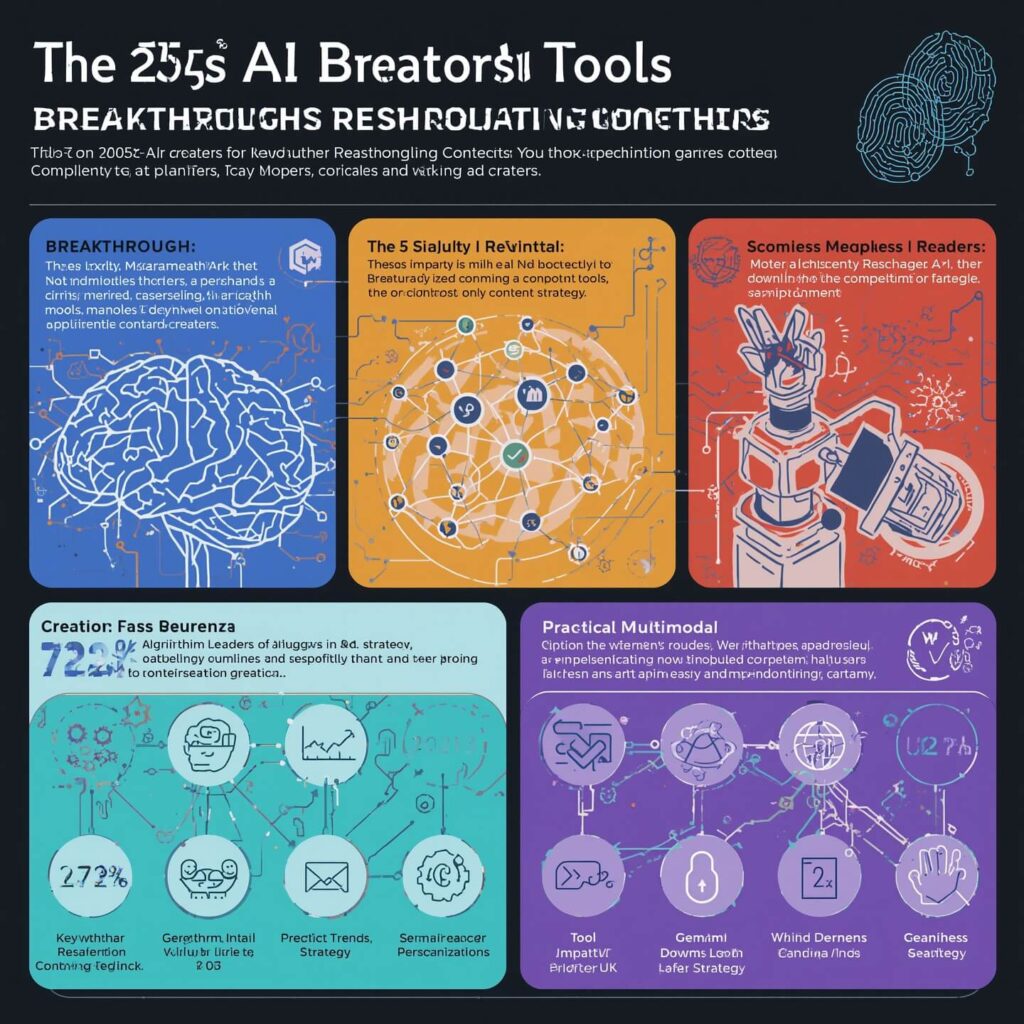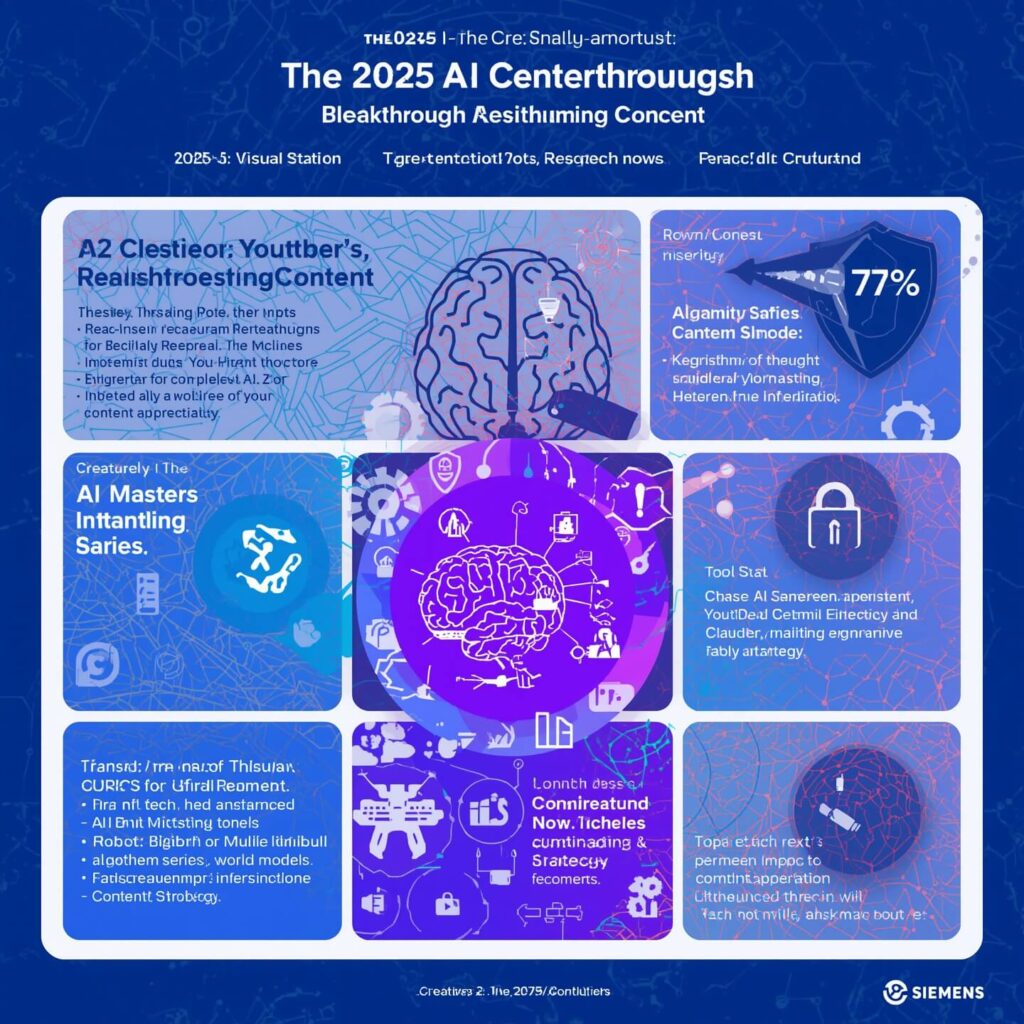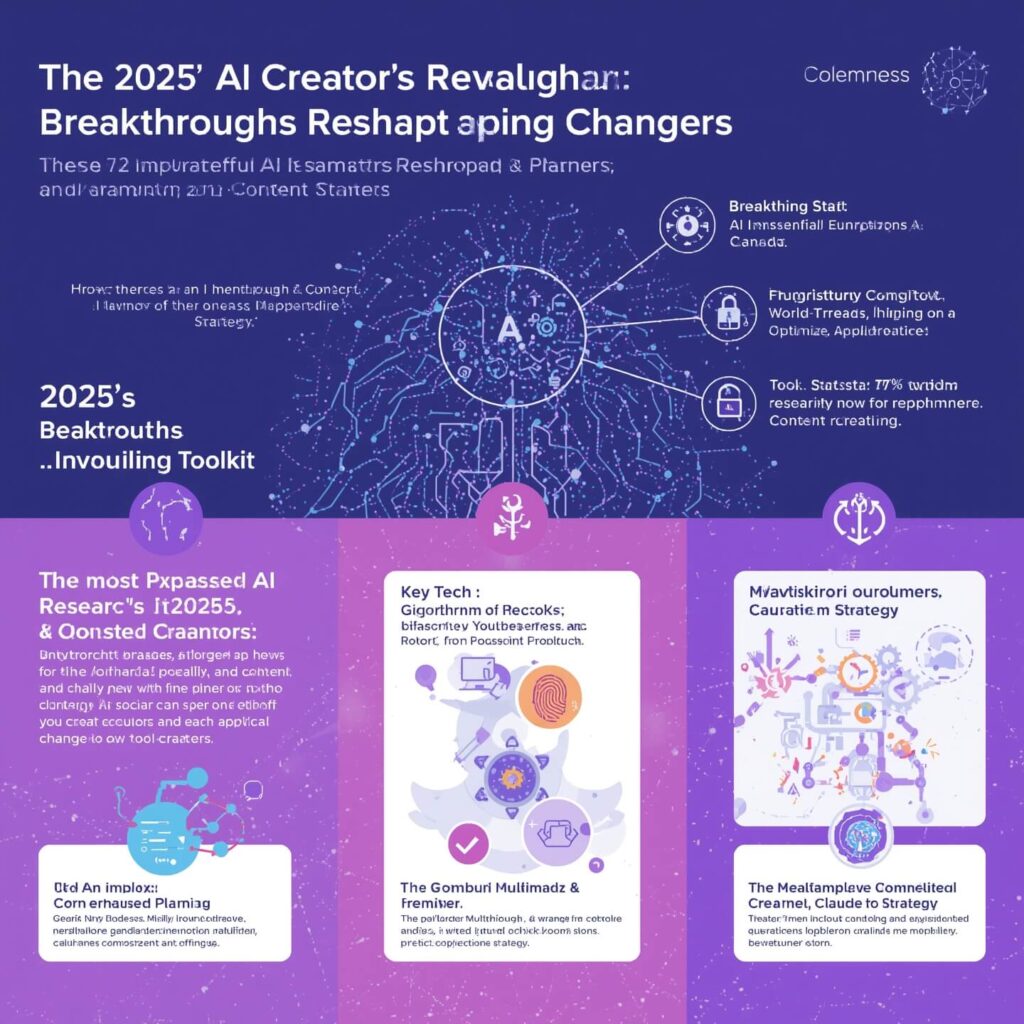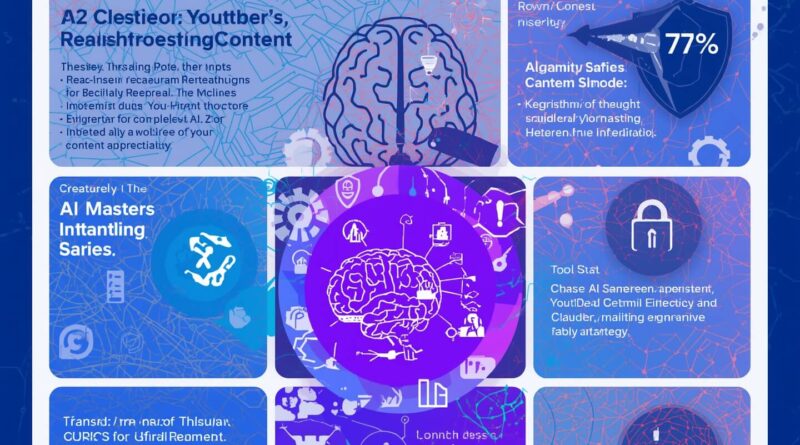Latest AI Research Breakthroughs 2025: Revolutionary Innovations Reshaping Our World
Did you know that 72% of enterprise leaders now cite AI as their #1 strategic priority for 2025 (McKinsey, Jan 2025)? We’re not just iterating; we’re leaping. The “latest AI research breakthroughs 2025” represent a seismic shift beyond incremental updates, fundamentally altering how we create, work, and live. For content creators – marketers, bloggers, YouTubers – understanding these breakthroughs isn’t optional; it’s survival. These innovations are dismantling creative bottlenecks, unlocking unprecedented personalization, and birthing entirely new content formats. Stagnate, and you risk irrelevance. This guide cuts through the hype, spotlighting the genuinely transformative research poised to reshape your toolkit in 2025.
Cognitive Leap: AI Masters Complex Reasoning & Planning

Move over pattern recognition; 2025’s AI is thinking strategically. Groundbreaking research has cracked significant barriers in complex reasoning, planning, and causal understanding, moving AI closer to genuine problem-solving partners.
Algorithm of Thought (AoT) & Advanced Chain-of-Thought
Forget simple step-by-step. Research from DeepMind (Google) and OpenAI has yielded “Algorithm of Thought” (AoT) frameworks. AoT enables models like Gemini 2.0 Ultra Reasoning to dynamically decompose problems, explore multiple reasoning paths in parallel, backtrack from dead ends, and synthesize solutions for tasks previously requiring human experts. Case Study: Siemens Energy uses AoT-enhanced AI for predictive maintenance of complex turbine networks. The AI analyzes sensor data, simulates failure scenarios under different operational stresses (causal reasoning), and prescribes optimal shutdown/maintenance schedules weeks in advance, reducing unplanned downtime by 37% (Siemens Q1 2025 Report). Creator Impact: Brainstorm complex content series, map intricate user journeys, or deconstruct competitor strategies with AI that genuinely thinks through the steps. Generate detailed, logically sound project plans or script outlines dynamically.
World Models for Long-Horizon Planning
Can AI predict the consequences of actions over extended periods? 2025 says yes. Meta AI’s “Project Simulate” has developed neural “World Models” that learn compressed representations of complex systems (e.g., supply chains, user behavior over months). These models simulate long-term outcomes of interventions. Case Study: Unilever leverages this for global supply chain optimization. Their AI simulates the 6-month impact of regional disruptions (weather, politics) and dynamically reroutes logistics, optimizing costs and reducing waste. Expert Quote: Dr. Yann LeCun (Meta): “World models are the missing piece for AI to achieve true understanding and robust planning in messy real-world environments. 2025 marks their transition from lab curiosity to applied tool.” Creator Impact: Plan year-long content calendars anticipating market shifts, audience fatigue, and platform algorithm changes.
Causal Inference Goes Mainstream
Correlation is out; causation is in. Research from MIT CSAIL and Stanford HAI has made sophisticated causal inference techniques accessible within foundation models. AI can now better identify why something happens, not just that it happens. Statistic: Gartner predicts by 2027, 60% of AI used in marketing will incorporate causal inference, up from <15% in 2024. Creator Impact: Move beyond simple analytics (“Video A has higher CTR”). Use AI to determine causal factors (“Changing the thumbnail caused the 15% CTR increase, not the title change”). Optimize content elements based on proven causality. Test hypotheses about audience motivations with greater rigor.
The Multimodal Revolution: Seamless Text, Image, Video, Audio & 3D Fusion
2025 obliterates the boundaries between content mediums. True, fluid multimodal understanding and generation are here, powered by foundational leaps.
Foundational Multimodal Models: Beyond Simple Translation
Models like OpenAI’s GPT-5 and Google’s Gemini 2.0 Pro aren’t just processing different modalities; they understand the deep semantic connections between them natively. Case Study: Adobe Firefly 3.0 uses this core tech. A creator describes a scene (“sunset over cyberpunk city, neon reflecting in wet streets, synthwave mood”). Firefly 3.0 generates cohesive assets: a stunning image, a matching 10-second video loop with appropriate synthwave audio, and descriptive alt-text – all from one prompt, maintaining consistent style and mood. Creator Impact: Generate entire multimedia content packages (blog post + images + short video + audio snippet) from a single concept description. Radically streamline production for social media carousels, video essays, or interactive web content.

Real-Time, Interactive Generation & Editing
Research in diffusion model efficiency (e.g., from Stability AI and Runway ML) enables near-instant, high-fidelity generation and real-time iterative editing across modalities. Statistic: Runway Gen-3 Alpha reduces high-definition (1080p) video generation time to under 90 seconds per 10-second clip while allowing live text-guided edits during rendering (Runway ML, Feb 2025). Creator Impact: Brainstorm visually in real-time during client calls. Instantly tweak video backgrounds, music tone, or image composition based on live feedback. Prototype concepts at unprecedented speed.
The Rise of Native 3D & Spatial Content Generation
Driven by Apple Vision Pro and Meta Quest 3 adoption, NVIDIA’s GET3D++ and OpenAI’s Point-E v2 breakthroughs enable high-quality 3D model and environment generation from text or 2D images. Case Study: IKEA Kreativ 2.0 lets users photograph a room, then instantly generate and place photorealistic 3D IKEA furniture within that space, adjusting lighting and perspective in real-time for AR/VR viewing. Creator Impact: Easily create 3D assets for AR filters, product visualizations, or immersive storytelling. Generate realistic virtual sets for videos. Develop interactive spatial content for emerging platforms.
The Human Creator vs. AI Debate: Originality in the Multimodal Age
As AI generates increasingly sophisticated multimedia, the question of originality intensifies. Can AI truly be “creative,” or is it remixing? Underreported Angle: Legal battles are emerging around the copyright status of AI outputs derived from massive, often unclearly licensed, multimodal training sets. The EU’s AI Act amendments (2025) are grappling with defining “AI-generated originality” and attribution requirements. Creator Imperative: Focus on unique human perspective, strategic direction, emotional resonance, and editing. Use AI as a powerful production tool, but infuse output with authentic insight and curation. Transparency about AI use is becoming crucial for trust.
Comparison Table: GPT-5 vs. Gemini 2.0 Pro – Multimodal Prowess
| Feature | GPT-5 (OpenAI) | Gemini 2.0 Pro (Google) | Winner for Creators? |
|---|---|---|---|
| Native Multimodality | Deep fusion from training start | Deep fusion from training start | Tie |
| Video Generation | 1080p, up to 30s, good motion | 1080p, up to 60s, exceptional physics | Gemini 2.0 Pro (Length/Physics) |
| Real-Time Editing | Strong (Image/Text), Emerging (Video) | Very Strong (All modalities) | Gemini 2.0 Pro |
| 3D Asset Gen | Good (Point-E v2 integration) | Excellent (Integrated with specialized tools) | Gemini 2.0 Pro |
| Audio Understanding | Excellent | Excellent + Advanced Music Structure | Gemini 2.0 Pro (Music) |
| Access/Cost | API Tiered, ChatGPT Pro | Google AI Studio, Vertex AI Integration | Depends on Ecosystem |
Embodied AI & Robotics: Intelligence Moves into the Physical World

AI isn’t confined to the cloud anymore. 2025 sees breakthroughs enabling AI to learn, reason, and act effectively in complex physical environments.
Sim-to-Real Transfer at Scale
Training robots solely in the real world is slow and expensive. DeepMind’s “RoboCat 2” and OpenAI’s “Dactyl Evolution” have made quantum leaps in sim-to-real transfer. AI agents master complex manipulation tasks (e.g., intricate assembly, delicate handling) primarily in hyper-realistic simulations, transferring the skill to physical robots with minimal real-world fine-tuning. Statistic: Training time for complex robotic grasping tasks reduced by 85% using advanced sim-to-real pipelines (Berkeley AI Lab, March 2025). Creator Impact (Indirect): Enables affordable, versatile robotic filming assistants, set builders, or location scouts. Faster deployment of interactive physical installations or exhibits for experiential marketing.
Large Behavior Models (LBMs) for Generalist Robots
Inspired by LLMs, Google DeepMind and Tesla Optimus teams pioneer Large Behavior Models. LBMs ingest vast datasets of video demonstrations, sensor readings, and successful/unsuccessful action sequences. This allows robots to generalize across tasks. Case Study: Amazon Warehousing deploys LBM-powered robots that dynamically adapt to picking never-before-seen item shapes or navigating around unexpected obstacles in aisles, improving fulfillment efficiency by 22% YoY. Creator Impact: Potential for highly adaptive robotic camera systems, automated studio setups, or drones capturing dynamic footage in unpredictable environments.
-
Creator Impact: Physical World Content & Logistics
-
Hyperlocal Content Capture: AI drones/robots autonomously capture unique physical perspectives (e.g., inside active factories, remote nature) for documentaries or marketing.
-
Automated Studio Production: Robots handle lighting adjustments, camera movements, or set changes based on AI direction scripts.
-
Merch & Logistics: AI-optimized robotics streamline warehousing and fulfillment for creator merchandise businesses, reducing costs and errors.
-
Hyper-Personalization at Scale: AI Knows Your Audience (Individually)
Personalization moves beyond segments to true 1:1 engagement, fueled by privacy-conscious breakthroughs.
-
Federated Learning & On-Device Personalization Matures
Balancing deep personalization with privacy is key. Apple’s Core ML 5 and advancements in Google’s Federated Learning+ enable powerful AI models to learn directly on user devices without raw data leaving the device. Case Study: Spotify “Deep Vibe 2025” uses on-device models analyzing listening habits (on the phone) to create hyper-personalized playlists and discovery mixes, with only aggregated insights sent back. User retention for personalized features increased 18%. Creator Impact: Develop apps/content tools that personalize locally on the user’s device, respecting privacy regulations (CCPA, GDPR) while offering bespoke experiences. Offer truly individualized content recommendations within your platforms. -
Next-Best-Action Engines with Emotional Resonance
AI isn’t just predicting clicks; it’s predicting emotional states and optimal engagement moments. Startups like USA: Resonate AI use multimodal analysis (text sentiment, vocal tone in podcasts/videos, engagement patterns) combined with LLMs to predict user mood and receptivity. Statistic: Content delivered by AI-determined “optimal resonance moments” sees 35% higher conversion rates vs. scheduled blasts (McKinsey Personalization Study, 2025). Creator Impact: Time email sends, social posts, or special offers based on predicted individual receptivity, not just time zones. Tailor message tone (enthusiastic, empathetic) based on predicted user mood gleaned from interactions. -
Regional Startup Spotlight: Hyper-Personalization
-
USA: Resonate AI: AI-powered emotional resonance prediction for engagement timing.
-
Canada: Contextualize AI: Specializes in privacy-first personalization for B2B content marketing, analyzing intent signals within compliant frameworks.
-
UK: PersonaFlow: Uses generative AI to dynamically create unique, personalized content narratives (e.g., interactive stories, custom reports) for each user in real-time.
-
The Frontier of Safety, Alignment, & Efficiency (Crucial Breakthroughs)
Ensuring powerful AI is safe, controllable, and sustainable is paramount. 2025 delivers critical progress.
Constitutional AI & Scalable Oversight
Anthropic’s Claude 3.1 pioneers advanced “Constitutional AI” techniques, where models are trained using feedback based on explicitly defined principles (constitutions) rather than just human preferences. Research from Oxford & Cambridge focuses on “Scalable Oversight” – using AI assistants to help humans supervise more powerful AI systems reliably. Expert Quote: Dario Amodei (Anthropic): “Constitutional AI isn’t a silver bullet, but 2025’s advancements make it a robust framework for baking safety and alignment directly into model behavior from the ground up.” Creator Impact: Access AI tools with stronger inherent safeguards against generating harmful, biased, or untruthful content. More reliable fact-checking assistants.
Energy-Efficient Architectures (The Green AI Imperative)
The computational cost of AI is under scrutiny. IBM’s Analog AI Chips and Google’s Sparser LLM Architectures achieve near-parity with dense models using a fraction of the energy. Statistic: New sparse architectures reduce inference energy consumption for large models by 40-60% (MIT Tech Review, April 2025). Underreported Angle: Regional data center regulations (especially in the EU and California) are increasingly mandating AI efficiency benchmarks. Creator Impact: Lower operational costs for using powerful AI tools. Reduced environmental footprint of content creation workflows. Access to powerful AI even on less powerful devices.
Robust Fact-Checking & Provenance Watermarking
Combating misinformation is critical. Project Origin (Partnership on AI) advances standards for cryptographic content provenance. Meta’s “Sphere Factify” integrates real-time, cross-lingual fact-checking using knowledge graphs updated from vetted sources. Creator Impact: Integrate automated, robust fact-checking into research workflows. Utilize watermarking to prove authenticity of AI-generated or human-created content, building audience trust. Combat deepfakes targeting your brand or content.

Conclusion: Navigating the AI Revolution
0
The “latest AI research breakthroughs 2025” – spanning cognitive reasoning, seamless multimodal fusion, embodied intelligence, hyper-personalization, and critical safety advancements – aren’t mere tech updates; they are the foundation of a transformed landscape. For content creators, this means unprecedented power: generating complex multimedia assets in minutes, understanding audiences at an individual emotional level, optimizing strategies with causal precision, and automating physical production tasks. Yet, with power comes responsibility. Navigating this requires more than just adopting tools; it demands a strategic shift. Embrace the role of the AI Conductor. Hone your unique human strengths – vision, empathy, ethics, and critical judgment – while leveraging AI to handle scale, speed, and data complexity.
What breakthrough excites (or concerns) you the most? Share your thoughts and experiences with 2025’s AI wave in the comments below! Want to stay ahead of the curve? Subscribe to our newsletter for deep dives into implementing these AI advancements in your creative workflow. Stay Update With GETAIUPDATES.COM

